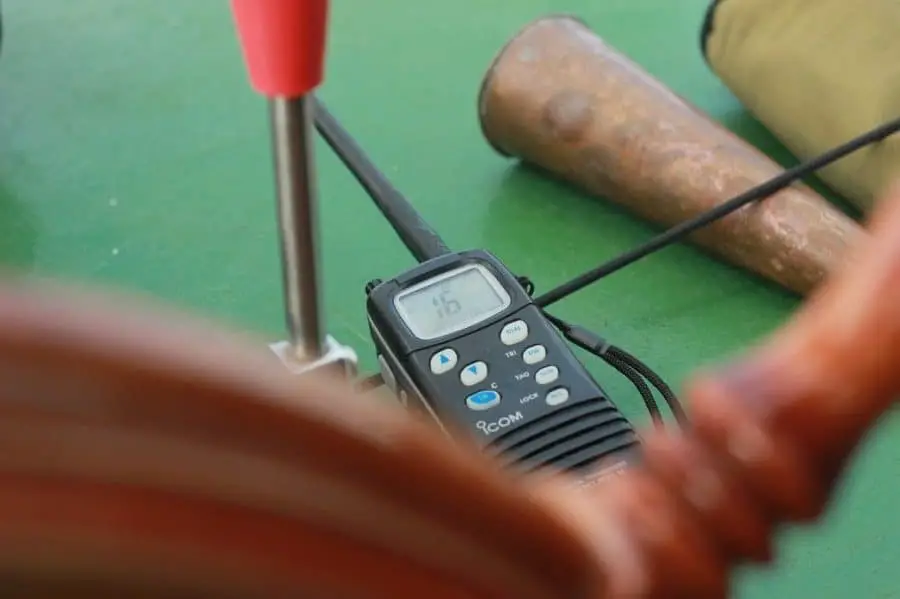Imagine you’re out on your sailboat enjoying the freedom of being able to explore this amazing blue planet without a care in the world and with just a sailboat and some breeze.
However, something happens out of the blue that requires immediate action and likely demands you to reach out for help; either from another boat or someone on-shore.
At this exact moment, you must know how to call for help on a boat so you and anyone else on-board are in the safest condition possible.
There is a multitude of situations that can occur while out on the water, so having several ways to communicate with other boats or people on-shore is an important safety requirement.
Luckily, there are many ways to ensure that you and everyone on board your sailboat are safe in the direst conditions. I’ve always been taught to “plan for the best and prepare for the worst”. That’s why I want to explore the many ways how to call for help when on a sailboat.
How to Call for Help on a Boat
Using a combination of VHF and visual signals is by far the most effective way to call for help on a boat. In the next couple of sections, we’ll dive deep into each of these to ensure your and your crew are ready for anything.
VHF Radio
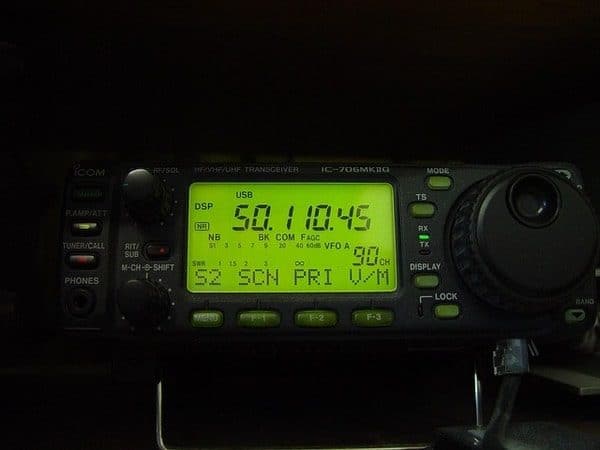
Communicating through a VHF (Very High Frequency) radio is by far the most common way to communicate between you and other boats or people on land.
All sailboats should have a reliable VHF radio that has an easy to use panel so you or anyone on your sailboat can get to it and use it when necessary.
A VHF radio is both a receiver and transmitter resulting in it being classified as a transceiver.
What this means is that you can both send and receive messages vocally through the unit to whoever is dialed into the channel or frequency you’re tuned in to and within range.
All VHF radios are able to tune into the same channels if they need, including the channels specifically aimed at providing information on weather, coast guard activity, shipping traffic, and emergencies.
When it comes to emergencies, channel 16 (156.8 MHz) is internationally designated and reserved for emergency calls such as “May Day”, “Pan Pan”, and “Securite”.
If you’re not in an emergency situation, you must not transmit anything over channel 16 unless responding to an emergency call that you can assist in.
However, if you are in an emergency situation while out on the water, you must be able to operate the VHF radio properly and be able to know when and how to call for help.
Securite (Safety) Call
A Securite call is the third most important call you’ll hear on an emergency channel. It’s highly unlikely you’ll ever have to use a Securite call since it’s largely used by Coast Guard stations to use safety warnings to all ships in a designated area.
Most of the time a Securite call is made is when there’s a navigational hazard in the area or an exceptional weather warning needs to be announced.
When it comes to Securite warnings, you’ll hear it announced on channel 16 that this particular warning is to be announced on another operation channel.
The reason for this is because they don’t want to clog up the transmission in case a more dire emergency needs to be communicated.
An example of a Securite call would look something like:
SECURITE, SECURITE, SECURITE
ALL STATIONS, ALL STATIONS, ALL STATIONS
THIS IS U.S. COASTGUARD MIAMI, US COASTGUARD MIAMI, U.S. COASTGUARD MIAMI
FOR REPETITION OF NAVIGATION WARNING LISTEN TO CHANNEL 22A/2670KHz
After about a minute or so, the official warning would then be announced on the channel specified in the original Securite call.
If you hear a Securite call like this on your VHF radio, you definitely want to listen up and tune into the channel they reference in case the warning involves you and your sailboat.
Pan Pan (Urgency) Call
A Pan Pan call is the second most important call you’ll hear on an emergency channel. A Pan Pan call is classified as an urgency call, which requires everyone able to hear it to listen up in case they’ll be affected by it.
This call is considered very serious and indicates that the safety of either a person or a boat is at serious risk.
A Pan Pan call is almost always made by another boat in an urgent situation which involves the safety of a person on-board the boat or the boat itself (and thus the entire crew).
It’s important to note that this call should only be made when there’s a serious risk to someone’s health or safety, including the boat as well. Before making a Pan Pan call, the captain or person responsible for the boat must give the authority to do so.
An example of a Pan Pan call would look something like:
PAN-PAN, PAN-PAN, PAN-PAN
ALL STATIONS, ALL STATIONS, ALL STATIONS
THIS IS
MILLENNIUM FALCON, MILLENNIUM FALCON, MILLENNIUM FALCON
MILLENNIUM FALCON
LATITUDE 17.604477, LONGITUDE -67.154312
WE ARE RUN AGROUND AND STUCK
WE NEED ASSISTANCE BEING PULLED OUT
*ANY FURTHER RELEVANT INFORMATION*
OVER
This call should be made on the emergency channel with a gap of a minute or so between each call until someone responds.
Depending on the circumstance, the responder may request you to move to another channel so you can proceed with resolving the issue together. Also, if you don’t know the exact latitude and longitude of your location, you must provide distance and bearing from a known point.
If you have a medical emergency and need to communicate that as an urgency signal, put the word “medico” after “pan pan” in the example above. For example:
PAN-PAN MEDICO, PAN-PAN MEDICO, PAN-PAN MEDICO
This will ensure that anyone listening who can provide medical assistance and/or advice will do so immediately. Likely the Coast Guard will pick this up right away and arrange for a doctor or medical professional to either come out with the assistance of the Coast Guard or provide medical advice.
May Day (Distress) Call
A May Day call is the most important call you’ll hear on an emergency channel. May Day calls take precedence over every other form of communication on emergency channels.
Thus, has top priority in terms of response. Absolutely nothing is allowed to disrupt this transmission while it’s going out.
The only time a May Day call should be made is when there’s a situation on board a boat that is both grave and imminent. These two words are important as the absolute only circumstance a May Day call is appropriate is when these two conditions are met.
If they are not, then any May Day call made will be considered a false alarm and can carry some pretty serious consequences for those on-board the calling boat.
As a matter of fact, the International Radio Regulations designated a May Day call to strictly include situations involving ships, aircraft, and other vehicles that are threatened by grave and imminent danger.
Since there was no mention of people, the International Conference on Safety of Life at Sea made sure people were included. It’s also acceptable to use a May Day call in case of a man overboard.
An example of a May Day call would look something like:
MAY DAY, MAY DAY, MAY DAY
THIS IS
MILLENNIUM FALCON, MILLENNIUM FALCON, MILLENNIUM FALCON
MILLENNIUM FALCON
LATITUDE 17.604477, LONGITUDE -67.154312
WE HAVE A PUNCTURED HULL AND ARE TAKING IN WATER
WE NEED TO BOARD ANOTHER SHIP
*ANY FURTHER RELEVANT INFORMATION*
OVER
Similar to a Pan Pan call, this call should be made on the emergency channel with a gap of a minute or so.
Also, if you don’t know the exact latitude and longitude of your location, you must provide distance and bearing from a known point. This distress call should be made on channel 16 using high power.
Relevant information you might want to include could be the number of people onboard your boat. This gives the Coast Guard or anyone coming to assist to know how many people are involved in the rescue.
Again, it’s extremely important that you only use a May Day call under the circumstances that involve the grave and imminent danger of anyone on your boat or the boat itself.
If the relevant authorities determine that it was a false alarm, even if it was a mistaken false alarm, the captain or owner of the boat may be prosecuted.
Visual Signals
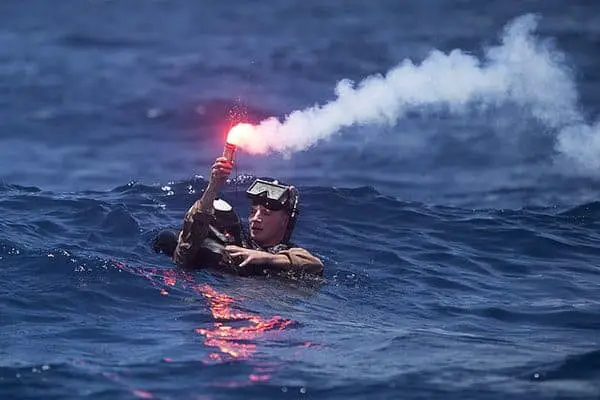
Alongside the use of a VHF radio, another commonly used way to indicate to other boats and people on-shore is through visual signals. These types of signals can include the use of flags, flares, and powerful electric lights.
Depending on whether you need to signal during the day or night, you’ll want to use different methods to get your point across most effectively.
Daytime Flares and Flags
When cruising around during the daytime and you find yourself in an emergency situation, you’ll want to use flags and flares to communicate to other vessels that you require assistance.
When it comes to signaling during the daytime, the go-to international color for distress is orange.
The most effective method for sending out a visual distress signal in the day time is to hoist an orange flag as high as you can on your sailboat. By placing an orange flag on the top of your tallest mast, you’ll be able to signal to vessels from miles away that you’re in need of assistance.
Another way to send out a distress signal during the daytime is to use a handheld orange smoke flare.
These types of flares emit a very large amount of smoke and last quite a long time so that anyone in a reasonable range will see it right away.
However, it’s important that you only use these flares at the right time when other vessels are around so as not to waste your stash of orange flares.
Nighttime Lights and Flares
An emergency situation on the water at nighttime can be a bit of a daunting situation, so knowing exactly what equipment to use is of the utmost importance.
The most common and effective tools to send out a visual signal to surrounding vessels during the nighttime is with the use of high-powered lights and flares.
By far the most effective method for signaling distress at nighttime is by using a high-powered SOS electric signal light. Just like the orange flag is used during a daytime distress signal, a strong SOS light should be placed at the highest point of your sailboat.
The great part of using one of these lights is that it’ll emit visual distress as long as the battery will last, which should be a very long time.
Apart from using an electric signal light, red flares are incredibly useful when needing to signal to other vessels around you that you require immediate assistance.
Unlike the orange flares used during the daytime, red flares don’t produce much smoke and are far brighter.
Red flares can come in handheld form as well as aerial devices that shoot up very high. Handheld flares can last around 3 minutes while aerial flares will burn for about 6 to 8 seconds.
Other Ways to Call For Help on a Boat
We’ve covered the most important ways to call for help on a boat, but there are some very useful technologies that can decrease the risk of any potential disaster when on the water.
Let’s take a look at a few of them now.
Personal Location Beacon (PLB)
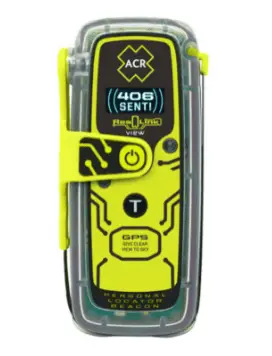
One of the most powerful ways you can ensure your and your crew’s safety while aboard a sailboat is to have a Personal Location Beacon (PLB) close at hand.
Without a doubt, using one of these devices can be the difference between an emergency situation going well and one going very bad.
The PLB is a device that allows anyone to send a distress signal through the use of satellite technology to the nearest Coast Guard station that can provide immediate assistance.
Just like when you send out a May Day call with a VHF radio, a PLB must only be used in the situation where a person or your boat is in grave and imminent danger.
Using a PLB is very easy and requires manual operation. Since it’s a device that needs to be used quickly and anywhere, they’re specifically designed to be easy to use and are usually small enough for you to carry around anywhere you go.
Generally, all that’s required to operate a PLB is to set it down on a flat surface, extend the antenna attached to it, and press a button. This will send out a distress signal at the correct frequency to the nearest Coast Guard station with your exact coordinates.
There are a lot of useful PLBs out there, but one the most popular is the ResQLink+ 406 Buoyant Personal Locator Beacon by ACR. It’s supposedly the smallest PLB in the world and requires no monthly or annual subscription service to operate (unlike other PLBs).
On top of that, it’s one of the most affordable PLBs you can buy and is a great insurance policy if you ever need to use it.
Emergency Position Indicating Radio Beacon (EPIRB)
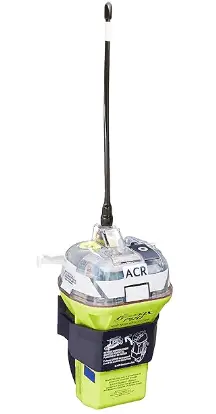
If you’re interested in increasing your level of safety to the maximum and want to go above and beyond the effectiveness of a PLB, then you’ll want to look at getting an Emergency Position Indicating Radio Beacon (EPIRB).
These devices are very similar to PLBs with the main difference being that they’re activated the moment they become submerged by water.
Regardless of whether or not you use a PLB, having an EPIRB attached to your sailboat is a very wise move. There may come a time when you have no choice but to signal for help with one of these devices and having an EPIRB attached to your boat will ensure that you get the help you need.
The best part about an EPIRB is that they require less interaction to be activated than a PLB. All that’s required is to through the device into the surrounding water and it’ll send out a distress signal with your local coordinates.
While a tab bit more pricey compared to a PLB, the GlobalFix Pro 406 2844 EPIRB by ACR is a steal when considering ease of use and effectiveness when in a serious jam out on the water.
Mobile Phone
Nowadays, everyone has a mobile phone and keeps it with them at all times. If you or anyone who’s on your sailboat has a mobile phone with reception, absolutely use it to contact those you need to get ahold of on land.
Of course, this will be highly dependent on how close your sailboat is to land, but this is probably the quickest way to get ahold of someone when you’re in a tough situation.
That doesn’t mean you can skip over the previous methods though, especially when you know for a fact that you’re in an emergency situation that requires effective communication among the other vessels or on-land personnel that can assist you.

